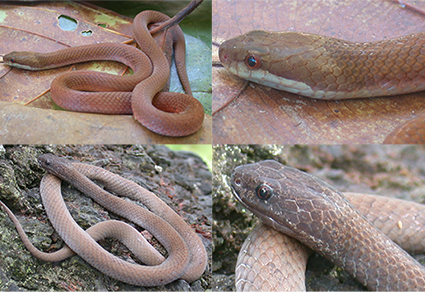Abstract
Papuan snakes of the genus Aspidomorphus have long been taxonomically problematic, but nomenclature within this group has been stable at three recognized species since 1967. Previous genetic work suggested the presence of a number of cryptic but currently unrecognized candidate species in the genus. In 2004, I obtained a series of Aspidomorphus from Sudest Island, Milne Bay Province, Papua New Guinea that were clearly different from currently recognized species, and I describe that species here as A. dimorphus sp. nov. This species exhibits a striking bimodality in color pattern in adults, here termed the “orange morph” and “dark morph”. This dimorphism is not related to sex, and both forms have earlier been shown to be genetically identical. Description of A. dimorphus sp. nov. begins the process of bringing taxonomic clarity to a genus long held in the grip of nomenclatural stasis. It furthermore highlights again the importance of Sudest Island for biodiversity endemism.
References
- Baldwin, S.L., Lister, G.S., Hill, E.J., Foster, D.A. & McDougall, I. (1993) Thermochronologic constraints on the tectonic evolution of active metamorphic core complexes, D’Entrecasteaux Islands, Papua New Guinea. Tectonics, 12, 611–628. https://doi.org/10.1029/93TC00235
- Barbour, T. (1908) Some new reptiles and amphibians. Bulletin of the Museum of Comparative Zoology, 51, 315–325.
- Boulenger, G.A. (1896) Catalogue of the snakes in the British Museum (Natural History). Vol. 3. Trustees of the Museum, London, 721 pp.
- Brongersma, L.D. (1934) Contributions to Indo-Australian herpetology. Zoologische Mededeelingen, 17, 161–251.
- Gemel, R., Gassner, G. & Schweiger, S. (2019) Katalog der Typen der herpetologischen Sammlung des Naturhistorischen Museums Wien – 2018. Annalen des Naturhistorischen Museums in Wien, B, 121, 33–248.
- Günther, A. (1872) Seventh account of new species of snakes in the collection of the British Museum. Annals and Magazine of Natural History, Series 4, 9, 13–37. https://doi.org/10.1080/002229372011951771
- Kaiser, H. (2014) Best practices in herpetological taxonomy: errata and addenda. Herpetological Review, 45, 257–268.
- Kaiser, H., Crother, B.I., Kelly, C.M.R., Luiselli, L., O’Shea, M., Ota, H., Passos, P., Schleip, W.D. & Wüster, W. (2013) Best practices: In the 21st Century, taxonomic decisions in herpetology are acceptable only when supported by a body of evidence and published via peer-review. Herpetological Review, 44, 8–23.
- Kraus, F. (2010) New species of Toxicocalamus (Squamata: Elapidae) from Papua New Guinea. Herpetologica, 65, 460–467. https://doi.org/10.1655/09-002.1
- Kraus, F. (2015) A new species of the miniaturized frog genus Paedophryne (Anura: Microhylidae) from Papua New Guinea. Occasional Papers of the University of Michigan Museum of Zoology, 745, 1–11.
- Kraus, F. (2019) New species of Lepidodactylus (Squamata: Gekkonidae) from New Guinea and adjacent islands. Zootaxa, 4651 (2), 305–329. https://doi.org/10.11646/zootaxa.4651.2.7
- Kraus, F. (2021) A herpetofauna with dramatic endemism signals an overlooked biodiversity hotspot. Biodiversity and Conservation, 30, 3167–3183. https://doi.org/10.1007/s10531-021-02242-3
- Kraus, F. (2024) New species of Gehyra (Squamata: Gekkonidae) from Papua New Guinea. Zootaxa, 5512 (2), 240–271. https://doi.org/10.11646/zootaxa.5512.2.8
- Kraus, F. (2025) New species of snakes of the genus Dendrelaphis (Squamata: Colubridae) from the Milne Bay Islands, Papua New Guinea. Zootaxa, 5618 (4), 451–480. https://doi.org/10.11646/zootaxa.5618.4.1
- Kraus, F., Kaiser, H. & O’Shea, M. (2022) Hidden diversity in semi-fossorial Melanesian forest snakes: a revision of the Toxicocalamus loriae complex (Squamata, Elapidae) from New Guinea. Vertebrate Zoology, 72, 997–1034. https://doi.org/10.3897/vz.72.e89647
- McDowell, S.B. (1967) Aspidomorphus, a genus of New Guinea snakes of the family Elapidae, with notes on related genera. Journal of Zoology, London, 151, 497–543. https://doi.org/10.1111/j.1469-7998.1967.tb02130.x
- Metzger, G.A., Kraus, F., Allison, A. & Parkinson, C.L. (2010) Uncovering cryptic diversity in Aspidomorphus (Serpentes: Elapidae): evidence from mitochondrial and nuclear markers. Molecular Phylogenetics and Evolution, 54, 405–416. https://doi.org/10.1016/j.ympev.2009.07.027
- Miller, S.R., Baldwin, S.L. & Fitzgerald, P.G. (2012) Transient fluvial incision and active surface uplift in the Woodlark Rift of eastern Papua New Guinea. Lithosphere, 4, 131–149. https://doi.org/10.1130/L135.1
- Schiefenhövel, W. (1969) Snakebite by Aspidomorphus muelleri. The Medical Journal of Australia, March 8, 515–517.
- Schlegel, H. (1837) Essai sur la physionomie des serpens. Partie Descriptive. M.H. Schonekat, Amsterdam, xv + 606 + [1] pp.
- Strickland, J.L., Carter, S., Kraus, F. & Parkinson, C.L. (2016) Snake evolution in Melanesia: origin of the Hydrophiinae (Serpentes, Elapidae) and the evolutionary history of the enigmatic New Guinean elapid Toxicocalamus. Zoological Journal of the Linnean Society, 178, 663–678. https://doi.org/10.1111/zoj.12423
- Taylor, B., Goodliffe, A.M. & Martinez, F. (1999) How continents break up: Insights from Papua New Guinea. Journal of Geophysical Research, 104, 7497–7512. https://doi.org/10.1029/1998JB900115
- Tiedemann, F., Häupl, M. & Grillitsch, H. (1994) Katalog der Typen der Herpetologischen Sammlung nach dem Stand vom 1. Jänner 1994. Teil II: Reptilia. Kataloge der wissenschaftlichen Sammlungen des Naturhistorischen Museums in Wien. Vertebrata Heft 4. Kataloge Band 10. Naturhistorisches Museum Wien, Vienna, 110 pp.
- Uetz, P., Freed, P., Aguilar, R., Reyes, F. & Hošek, J. (Eds.) (2025) The Reptile Database. Available from: http://www.reptile-database.org (accessed 21 March 2025)
- van Rooijen, J., Vogel, G. & Somaweera, R. (2015) A revised taxonomy of the Australo-Papuan species of the colubrid genus Dendrelaphis (Serpentes: Colubridae). Salamandra, 51, 33–56.
- Werner, F. (1903) Neue Reptilien und Batrachier aus dem naturhistorischen Museum in Brüssel. Zoologischer Anzeiger, 26, 246–253.
- Werner, F. (1925) Neue oder wenig bekannte Schlangen aus dem Wiener naturhistorischen Staatsmuseum (2. Teil). Sitzungsberichten der Akademie der Wissenschaften in Wien, Mathematisch-Naturwissenschaftliche Klasse, Abteilung 1, 134, 39–66.


